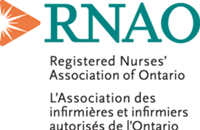TORONTO, Dec. 2, 2015 /CNW/ - Yet another major report suggesting that Community Care Access Centres (CCAC) are not meeting the needs of Ontarians is further proof that bold structural reforms are urgently needed, says the association representing the province's registered nurses (RN), nurse practitioners (NP) and nursing students.
Ontario's Auditor General Bonnie Lysyk released her annual report today, and one of the foremost topics was the CCACs, the 14 regional agencies charged with co-ordinating home and community care for about 700,000 Ontarians. The report found that CCACs are providing inconsistent levels of care across the province, not effectively overseeing the 160 agencies to which they contract care, and leaving too many Ontarians on lengthy wait lists for care.
This comes as no surprise to the Registered Nurses' Association of Ontario (RNAO), which has long advocated for major changes to home and community care.
"The evidence is clear and the jury is in: the home and community care system as it is currently structured is failing Ontarians," says RNAO Chief Executive Officer (CEO) Doris Grinspun.
Today's annual report comes just two months after Lysyk released a special report on CCACs, which found glaring gaps and inefficiencies in services. As little as 61 per cent of the $2.5 billion the province spends annually on CCACs goes toward face-to-face care, the report found. In March, another report from the Expert Group on Home and Community Care called for "urgent action" to make the sector more accountable, easier to navigate, and to provide more equitable care. And as far back as 1998, auditor general reports have detailed troubling disparities in services provided by the CCACs.
"How many more reports will it take, how many more taxpayer dollars will be wasted, and how much worse will things get, before the government moves forward with substantial structural reform?" Grinspun asks.
The province announced a multi-phased strategy to improve home and community care in May. In November, Health Minister Eric Hoskins suggested bolder conversations about the structure of the system were on the horizon.
RNAO applauded Hoskins for taking first steps toward repairing the home and community care system, and offered a blueprint for much-needed structural reform. The association's report, Enhancing Community Care for Ontarians (ECCO), first released in 2012, lays out a vision for a more person-centred and efficient system that will better meet the needs of Ontarians. Under ECCO's plan, the Local Health Integration Networks (LHIN) would take over whole system planning, funding allocation, and accountability, bringing together tighter integration and co-ordination between all sectors. Currently, LHINs deal mainly with hospital care, while CCACs look after home care and long-term care, but neither agency co-ordinates public health or primary care – with the exception of community health centres. This fragmented model leads to gaps in services.
"As the auditor general points out, the province has not clearly defined the LHINs' mandate to provide a fully integrated health system," says RNAO president Vanessa Burkoski. "We are confident that giving the LHINs more resources and a clear mandate to broaden their scope to include the whole system will result in more co-ordinated health care for Ontarians and a high-performing health system."
ECCO also focuses on the vital role of the province's 3,500 care co-ordinators, most of whom are RNs, which today's report says are often overworked and face significant roadblocks in their current positions at CCACs. Under ECCO, they would be transitioned from the CCACs into primary care, where they would be best positioned to co-ordinate care and help people navigate the health system. This would also serve to further strengthen primary care in places like nurse practitioners-led clinics (NPLC), which Lysyk's report noted were surpassing their patient targets. RNAO was the driving force behind the creation of Ontario's 26 NPLCs.
"Once these responsibilities have been transferred to the LHINs and primary care, the CCACs can be dissolved, saving $200 million annually which can be reinvested in direct frontline home care," Burkoski says.
"Ontario's nurses have recognized the need for change, and presented a way forward to provide the best care and make the best use of our limited resources. Now it's up to government to be decisive, and act immediately to prevent Ontarians from falling through the cracks."
The Registered Nurses' Association of Ontario (RNAO) is the professional association representing registered nurses, nurse practitioners, and nursing students in Ontario. Since 1925, RNAO has advocated for healthy public policy, promoted excellence in nursing practice, increased nurses' contribution to shaping the health-care system, and influenced decisions that affect nurses and the public they serve. For more information about RNAO, visit our website at RNAO.ca or follow us on Facebook and Twitter.
SOURCE Registered Nurses' Association of Ontario
Image with caption: "RNAO CEO Doris Grinspun (CNW Group/Registered Nurses' Association of Ontario)". Image available at: http://photos.newswire.ca/images/download/20151202_C4275_PHOTO_EN_557392.jpg

or to interview a nurse, please contact: Daniel Punch, Communications Officer/Writer, Registered Nurses' Association of Ontario (RNAO), Phone: 416-408-5606 / 1-800-268-7199 ext. 250, [email protected]

Share this article